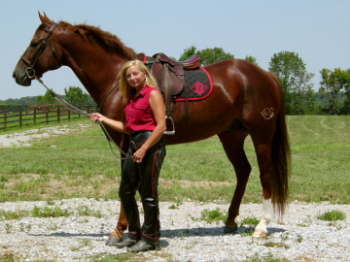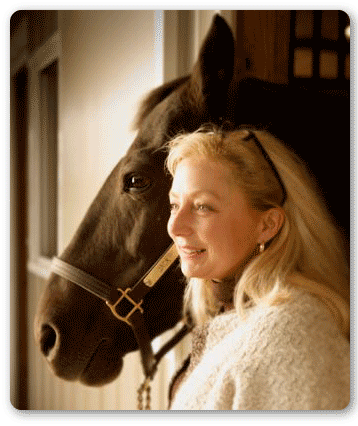Whoa: Getting Your Horse to Stop

It's one of the first things that should be taught to a horse from the ground, and soon after the horse has been ridden for the first few times. If you're having trouble, use these simple training methods to help put that desired ''whoa'' on your horse. Whether young or old, these methods apply to all horses.
The ''Whoa'' Stop.
The ''whoa'' stop is the first method of stopping. It simply means that when you say ''whoa'', your horse stops. You shouldn't have to pull back on the reins while saying ''whoa'' to get the horse to halt. If you have to, then it is not a ''whoa'' stop. If your horse doesn't stop when you say ''whoa'', or you need contact between your reins and your horse's mouth, there is an easy fix to correct this problem. When you prepare to halt your horse and say ''whoa'', keep your hands in the ''neutral'' position. Make sure you have no contact with the horse's mouth. When you say ''whoa'', sit deep in your saddle, using your weight to signal to the horse that a stop is coming.
If your horse doesn't stop when you say ''whoa'', immediately pull back on the reins to get the horse to a stop. After stopping, ask your horse to back up, a punishment for not stopping on your ''whoa''. Let your horse stand for a few seconds, and then ask him to walk off again. Walk a few steps and repeat the procedure. Continue to repeat the procedure until the horse stops when you say ''whoa'' without any contact from the reins.
It is helpful to have somebody watch you do this to make sure that you aren't pulling back on the reins, which you may do without realizing. After repeating the process several times, your horse should catch on and stop on your ''whoa.'' When your horse does stop on ''whoa'', let him stand for a minute and praise him by patting him on the neck. This is his reward for doing what you have asked. These techniques works best when applied at the walk first, then the trot or jog, and then at a lope or canter. Make sure you have mastered the technique at the walk first before you move on.
The Pull Stop.
The pull stop is simply what it implies; you pull back on the reins to stop your horse. Make sure you do not say ''whoa'' when you do the pull stop. By having two different stops, it allows you to try two methods in case your horse becomes spooked and runs off. When using the pull stop, make sure that you are not jerking on your horse. Make light contact with the horse's mouth, and give him a chance to stop. Do not pull hard every time you do ask him to stop, or you will have to keep pulling harder each time a stop is asked for. The procedure for correcting a pull stop is the same as a ''whoa'' stop. When you ask for the pull stop and your horse doesn't stop right away, bring him to a halt, and then back him up a few steps. Let him stand a few seconds, walk off and then repeat the procedure.
If your horse pulls through the reins and doesn't want to stop, you can take one of reins and pull his head around towards your knee. This throws his weight off-balance, making it harder for him to go forward. Once he has stopped, back him up, let him stand and then try it again. You may have to pull him around several times before he readily stops. Ideally, when you ask your horse to pull stop, you should be able to pull lightly without him lugging or pulling at the bit. Master this technique at the walk first, then move on to the trot or jog, canter or lope.
There is also a third method of stopping called a spur-stop.
This method is mainly used on western pleasure and horsemanship horses. It should only be taught by professionals who are familiar with it and know how to teach it and use it. Instead of pulling or saying ''whoa'', the rider applies both spurs at the same time and the horse halts. This is contrary to what spurs are usually used for, making the horse move out. If not taught properly, the horse may become confused and refuse to go forward. The spur stop can be a useful tool for the show ring. It makes stops cleaner, and it makes it look as though the rider didn't even cue the horse. Use this method only if you are familiar with it, or seek a professional who knows how to use it.
Stopping your horse is essential in every discipline, from dressage to western pleasure. Make sure your horse can stop on ''whoa'', and with a pull stop. These stops will not only make your horse listen better, but your horse will be more of a pleasure to ride as well. As always, seek the help of a professional if you are not sure what to do, or if you have a problem horse.
 Debbie has over 45 years experience with horses and equine-related businesses. She has owned, trained, boarded horses and run stables at various times in her career. She is a certified fence installer, has given balanced riding lessons, and has shown horses in Western, Western Pleasure, Trail, English, Hunter/Jumper, Fox Hunting, Hunter Trials, Dressage and driving classes. Debbie has been involved in foaling, and just about every aspect of horse ownership possible, and she welcomes your questions and comments. If you are interested in using any articles by Debbie, please send her an email.
Debbie has over 45 years experience with horses and equine-related businesses. She has owned, trained, boarded horses and run stables at various times in her career. She is a certified fence installer, has given balanced riding lessons, and has shown horses in Western, Western Pleasure, Trail, English, Hunter/Jumper, Fox Hunting, Hunter Trials, Dressage and driving classes. Debbie has been involved in foaling, and just about every aspect of horse ownership possible, and she welcomes your questions and comments. If you are interested in using any articles by Debbie, please send her an email.
